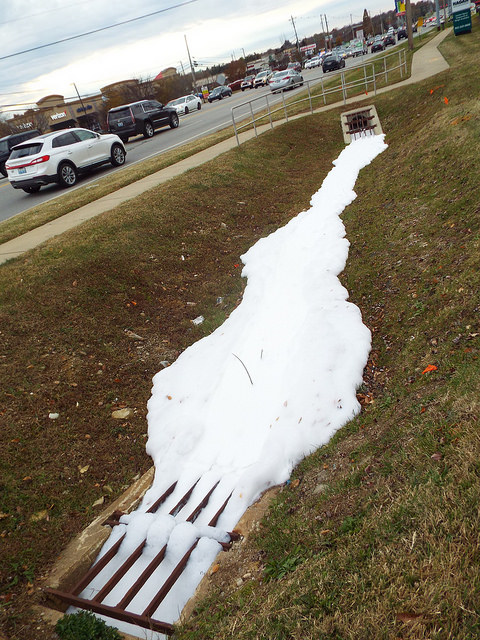Swale

|
| Photo credit: EX22218 - ON/OFF on Visualhunt.com / CC BY-NC-ND |
[edit] Introduction
Swales are natural or man-made linear depressions (or ditches), usually grass covered, with shallow-sloping sides. They are becoming more common as components in the drainage strategies of residential, commercial and municipal schemes.
Approved Document H - Drainage and Waste Disposal, describes ‘swales’ as:
‘…grass-lined channels which transport rainwater from a site as well as controlling flow and quality of surface runoff. Some of the flow infiltrates into the ground. There may be an overflow at the end into another form of infiltration device or a watercourse. They are particularly suitable for treatment of runoff from small residential developments, parking areas and roads.’
Their function is to:
- Slow the movement of water through the landscape after heavy rainfall;
- Reduce peak flows;
- Form a temporary reservoir;
- Direct water to a storage or discharge system and
- Facilitate the absorption of water into the ground.
Swales are frequently located alongside road verges, near the source of water run-off and can form a network linking storage ponds and wetlands. They can offer an efficient way of capturing rainwater and may form part of a sustainable urban drainage system (SuDS).
They can be both sustainable and economic because they are relatively easy to construct and can obviate the need for costly kerbs, gullies and gratings, as well as requiring little maintenance, other than mowing during the growing season. A grass length of around 150mm is considered optimal. Furthermore, swales can form good habitats for toads, newts and other amphibians which might have lower survival rates in conventional manufactured gullies.
[edit] How they work
In dry weather, a swale will hold little or no water. After a period of heavy rainfall, water will flow into the swale but its flow will be slowed by the grass which also filters out sediments and organic matter that remain on the top surface to be broken down naturally. Optimum performance usually relies on shallow slopes – both along the swale and on its sides. This may be further enhanced by installing check dams across the direction of flow; this will reduce the flow rate and lower the erosion risk.
A swale’s regulating function is enhanced by the processes of evaporation, infiltration into the surrounding soil and transpiration. If periods of exceptionally heavy rain are anticipated, overflows can be created to link to watercourses, storage ponds or wetlands.
Swales may recharge an underlying aquifer but if this is undesirable, an impermeable lining can be installed beneath the swale.
NB Trees in Hard Landscapes, A Guide for Delivery, published by the Trees and Design Action Group in September 2014, defines a swale as: ‘…a shallow vegetated channel designed to partially treat water quality, attenuate flooding potential and convey surface water runoff away from critical infrastructure.’
[edit] Related articles on Designing Buildings Wiki
- Are sustainable urban drainage systems the response to our changing climate?
- Bioretention system.
- Berm.
- Bund.
- Catchment flood management plans.
- Culvert.
- Detention pond.
- Drainage.
- Eutrophication.
- Rainwater harvesting.
- River engineering.
- Safe working in drains and sewers.
- Soakaway.
- SuDS infographic.
- SuDS - is there light at the end of the tunnel?
- Surface water
- Sustainable urban drainage systems SUDS.
- Water Act 2014.
- Water consumption.
- Water engineering.
Featured articles and news
Infrastructure that connect the physical and digital domains.
Harnessing robotics and AI in challenging environments
The key to nuclear decommissioning and fusion engineering.
BSRIA announces Lisa Ashworth as new CEO
Tasked with furthering BSRIA’s impressive growth ambitions.
Public buildings get half a million energy efficiency boost
£557 million to switch to cleaner heating and save on energy.
CIOB launches pre-election manifesto
Outlining potential future policies for the next government.
Grenfell Tower Inquiry announcement
Phase 2 hearings come to a close and the final report due in September.
Progress from Parts L, F and O: A whitepaper, one year on.
A replicated study to understand the opinion of practitioners.
ECA announces new president 2024
Electrical engineer and business leader Stuart Smith.
A distinct type of countryside that should be celebrated.
Should Part O be extended to existing buildings?
EAC brands heatwave adaptation a missed opportunity.
Definition of Statutory in workplace and facilities management
Established by IWFM, BESA, CIBSE and BSRIA.
Tackling the transition from traditional heating systems
59% lack the necessary information and confidence to switch.
The general election and the construction industry
As PM, Rishi Sunak announces July 4 date for an election.
Eco apprenticeships continue help grow green workforce
A year after being recognised at the King's coronation.
Permitted development rights for agricultural buildings
The changes coming into effect as of May 21, 2024.





















